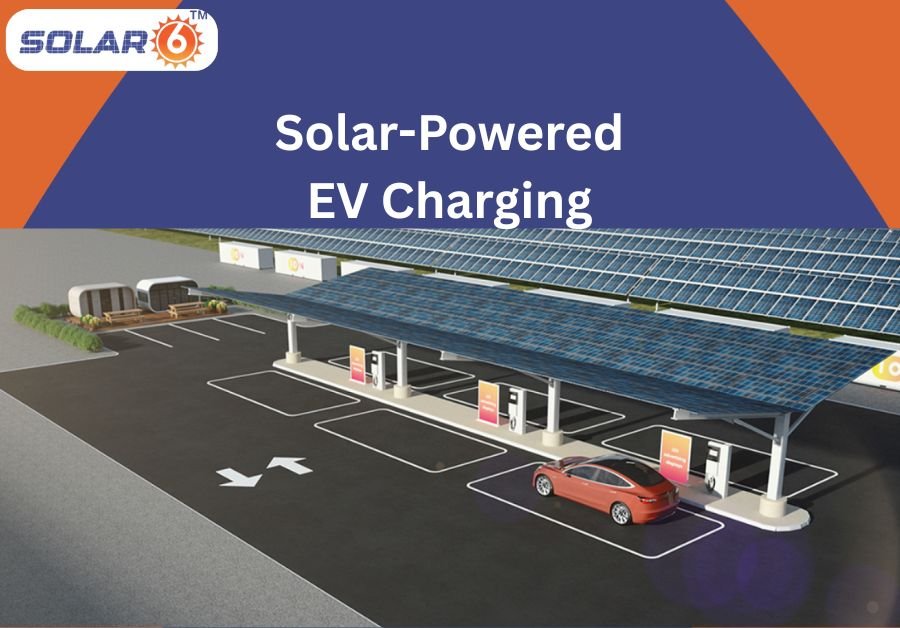As the world shifts in the direction of purifier and extra sustainable modes of transportation, the rise of electric vehicles (EVs) has turn out to be a defining feature of the 21st century. But as EV adoption will increase, so will the demand for green, eco-friendly, and cost-effective EV charging infrastructure. One modern solution that is gaining momentum is sun-powered EV charging stations. These revolutionary systems provide flexible solar electricity with electric mobility, enabling smooth, green, and independent power resources for the global fleet of EVs.
In this complete guide, solar6 will explore how solar panels are powering the future of EV charging, the technology behind it, the benefits, the challenges, and the worldwide trends shaping this sustainable motion.
The Rise of Electric Vehicles and the Charging Demand
Over the last decade, the electric automobile market has exploded. Governments across the globe are pushing for zero-emission delivery, providing subsidies and mandating bans on internal combustion engines shortly. As a result, EV income has surged, and with that comes a soaring demand for reliable EV charging stations.
Currently, most charging stations are related to the grid, which, in many locations, still relies on fossil fuels. This raises concerns approximately the real sustainability of electric vehicles. That’s where solar power comes into play. By integrating solar panels with EV charging stations, we can decarbonize the charging system, offering a in reality green solution from supply to socket.
How Solar-Powered EV Charging Works
Photovoltaic (PV) panels are used in solar-powered EV charging stations to convert sunlight into electricity. This energy is either used at once to power electric-powered cars or stored in battery energy storage systems (BESS) to be used when the sun isn’t shining.
There are typically two types of solar EV charging setups:
On-Grid Solar Charging Stations
These are connected to the utility grid and use solar energy during the day while drawing power from the grid at night or during cloudy days. Surplus solar energy can be fed back to the grid, earning credits in regions with net metering policies.
Off-Grid Solar Charging Stations
Completely independent of the utility grid, these stations use solar panels and battery storage to supply power. They are ideal for remote locations or disaster-prone areas where grid reliability is an issue.
Key Components:
- Solar panels (monocrystalline/polycrystalline)
- Inverters (DC to AC conversion)
- EV chargers (Level 1, Level 2, or DC fast chargers)
- Battery energy storage systems
- Smart charging controllers and software
Benefits of Solar EV Charging Stations
1. Clean and Renewable Energy Source
Solar energy is one of the cleanest sources of energy to be had. It generates energy without emitting greenhouse gases, making EV charging stations powered through solar panels green.
2. Cost Savings on Energy
Once installed, solar panels considerably reduce power costs. For businesses, municipalities, and EV fleet operators, this translates to decreased operational costs and long-term economic savings.
3. Energy Independence
Solar-powered charging stations reduce dependence on the utility grid. This is mainly essential in regions with high electricity rate or unreliable power delivery.
4. Scalability and Flexibility
Solar charging stations may be scaled as needed, with extra panels or chargers introduced to fulfill demand. They may be established in parking lots, highway rest stops, commercial spaces, or residential groups.
5. Sustainability Branding
Businesses that spend money on solar EV infrastructure decorate their sustainability image. This appeals to environmentally aware purchasers and stakeholders.
Trendy Technologies Shaping the Future
🌞 Smart Solar Charging
Using AI and IoT-powered energy control structures, clever chargers optimize energy go with flow between solar panels, the garage, EVs, and the grid. This reduces height load strain and increases performance.
🔋 Vehicle-to-Grid (V2G) Integration
With V2G, EVs can feed unused power returned to the grid or a building. When mixed with sun energy, this creates a two-way power environment that balances strength usage dynamically.
🚗 Fast Charging with Solar Boost
Innovations in the rapid-charging era, along with DC ultra-fast chargers, are being included with solar electricity systems and battery backups to offer high-speed charging without stressing the grid.
📱 App-Based Charging and Monitoring
EV drivers can now locate solar-powered chargers, reserve slots, and monitor energy usage via cellular apps, making the user enjoy seamless and digital-pleasant.
Global Trends in Solar EV Charging
United States:
States like California, Texas, and Florida are main the sun-powered EV charging movement, with several public-private partnerships launching sun-powered EV charging stations in town centers and along highways.
Europe:
The development of solar charging infrastructure has been expedited by way of the EU’s Green Deal and its force to attain carbon neutrality by 2050. Nations which including Norway, the Netherlands, and Germany are rapidly implementing solar-powered chargers.
India:
India is witnessing a solar revolution, with state governments and private groups launching solar-included EV charging hubs. Rooftop sun charging for two-wheelers and e-rickshaws is gaining popularity.
China:
As the most important EV market globally, China is making an investment in smart sun-charging infrastructure to support its huge EV fleet.
Challenges and Solutions
⚠️ High Initial Investment:
Solar EV charging stations require a significant upfront funding in solar panels, batteries, and infrastructure. However, fees are dropping swiftly, and going back on funding is more and more favorable.
Solution:
Government subsidies, green financing, and public-private partnerships can offset costs and promote adoption.
☁️ Weather Dependency:
Solar charging efficiency depends on sunlight availability. This can be an issue in regions with low solar insolation or during rainy seasons.
Solution:
Battery storage systems and hybrid setups (solar + grid) ensure 24/7 reliability.
🔌Limited Fast-Charging Options
Solar-powered stations traditionally supported Level 2 chargers, which are slower. Fast charging with solar energy requires high-capacity storage and advanced infrastructure.
Solution:
Combining solar with lithium-ion or flow batteries and deploying DC fast chargers with solar backups is solving this bottleneck.
Solar EV Charging for Residential and Commercial Use
Home Solar EV Chargers:
More owners are putting in rooftop solar structures with integrated EV chargers. This enables off-grid, cost-green charging for personal electric-powered automobiles.
Commercial Charging Stations:
Businesses, malls, and corporate parks are putting in solar-powered EV stations to attract eco-aware clients, reduce energy bills, and meet sustainability goals.
Fleet Charging:
Solar-powered fleet charging is right for logistics organizations, cab aggregators, and public delivery. It ensures predictable power fees and aligns with ESG (Environmental, Social, and Governance) commitments.
The Road Ahead: Building a Solar EV Ecosystem
🚧 Policy Support:
Governments internationally are introducing mandates, subsidies, and tax benefits to encourage the improvement of solar charging infrastructure.
🏢 Public-Private Collaborations:
Joint ventures among municipalities, strong organizations, and EV producers are essential to build significant networks of solar EV chargers.
🌍 Urban Planning Integration:
Smart cities are now integrating solar EV charging stations into urban development plans. This includes solar Roofs in parking lots and street-side chargers with solar rooftops.
Conclusion: Driving into a Cleaner Tomorrow:
The Solar panels and EV charging stationsrepresents a pivotal shift in sustainable transportation. By harnessing the full strength of the solar, we are able to create a clean, efficient, and scalable infrastructure that helps the developing wave of electrical vehicles. From property homeowners and local businesses to governments and international agencies, stakeholders throughout the spectrum are investing in this future-ready solution.
As battery generation evolves, solar panel performance improves, and EV adoption skyrockets, sun-powered EV charging stations will become a cornerstone of worldwide power and delivery structures. The future of mobility is not truly electric-powered—it’s solar-electric powered. Install Solar6 solar Panels and elevate your career with us.

